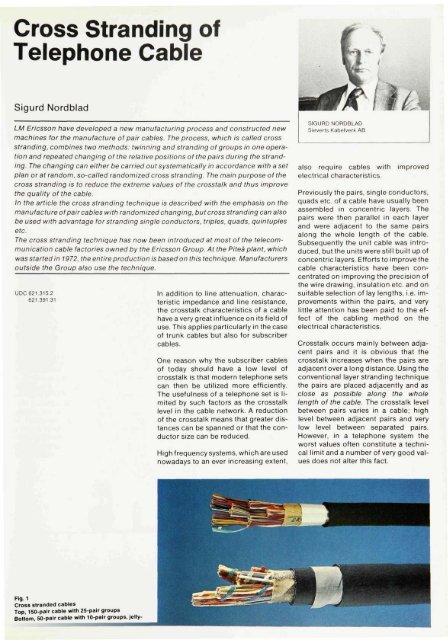Selection and Testing of Electronic Components for LM
Selection and Testing of Electronic Components for LM
Selection and Testing of Electronic Components for LM
Create successful ePaper yourself
Turn your PDF publications into a flip-book with our unique Google optimized e-Paper software.
Cross Str<strong>and</strong>ing <strong>of</strong><br />
Telephone Cable<br />
Sigurd Nordblad<br />
<strong>LM</strong> Ericsson have developed a new manufacturing process <strong>and</strong> constructed new<br />
machines <strong>for</strong> the manufacture <strong>of</strong> pair cables. The process, which is called cross<br />
str<strong>and</strong>ing, combines two methods: twinning <strong>and</strong> str<strong>and</strong>ing <strong>of</strong> groups in one operation<br />
<strong>and</strong> repeated changing <strong>of</strong> the relative positions <strong>of</strong> the pairs during the str<strong>and</strong>ing.<br />
The changing can either be carried out systematically in accordance with a set<br />
plan or at r<strong>and</strong>om, so-called r<strong>and</strong>omized cross str<strong>and</strong>ing. The main purpose <strong>of</strong> the<br />
cross str<strong>and</strong>ing is to reduce the extreme values <strong>of</strong> the crosstalk <strong>and</strong> thus improve<br />
the quality <strong>of</strong> the cable.<br />
In the article the cross str<strong>and</strong>ing technique is described with the emphasis on the<br />
manufacture <strong>of</strong> pair cables with r<strong>and</strong>omized changing, but cross str<strong>and</strong>ing can also<br />
be used with advantage <strong>for</strong> str<strong>and</strong>ing single conductors, triples, quads, quintuples<br />
etc.<br />
The cross str<strong>and</strong>ing technique has now been introduced at most <strong>of</strong> the telecommunication<br />
cable factories owned by the Ericsson Group. At the Piteå plant, which<br />
wasstartedin 1972, the entire production is based on this technique. Manufacturers<br />
outside the Group also use the technique.<br />
UDC 621.315.2<br />
621.391.31<br />
Fig. 1<br />
Cross str<strong>and</strong>ed cables<br />
Top, 150-pair cable with 25-pair groups<br />
Bottom, 50-pair cable with 10-pair groups, jelly-<br />
In addition to line attenuation, characteristic<br />
impedance <strong>and</strong> line resistance,<br />
the crosstalk characteristics <strong>of</strong> a cable<br />
have a very great influence on its field <strong>of</strong><br />
use. This applies particularly in the case<br />
<strong>of</strong> trunk cables but also <strong>for</strong> subscriber<br />
cables.<br />
One reason why the subscriber cables<br />
<strong>of</strong> today should have a low level <strong>of</strong><br />
crosstalk is that modern telephone sets<br />
can then be utilized more efficiently.<br />
The usefulness <strong>of</strong> a telephone set is limited<br />
by such factors as the crosstalk<br />
level in the cable network. A reduction<br />
<strong>of</strong> the crosstalk means that greater distances<br />
can be spanned or that the conductor<br />
size can be reduced.<br />
High frequency systems, which are used<br />
nowadays to an ever increasing extent,<br />
SIGURD NORDBLAD<br />
Sieverts Kabelverk AB<br />
also require cables with improved<br />
electrical characteristics.<br />
Previously the pairs, single conductors,<br />
quads etc. <strong>of</strong> a cable have usually been<br />
assembled in concentric layers. The<br />
pairs were then parallel in each layer<br />
<strong>and</strong> were adjacent to the same pairs<br />
along the whole length <strong>of</strong> the cable.<br />
Subsequently the unit cable was introduced,<br />
but the units were still built up <strong>of</strong><br />
concentric layers. Ef<strong>for</strong>ts to improve the<br />
cable characteristics have been concentrated<br />
on improving the precision <strong>of</strong><br />
the wire drawing, insulation etc. <strong>and</strong> on<br />
suitable selection <strong>of</strong> lay lengths, i.e. improvements<br />
within the pairs, <strong>and</strong> very<br />
little attention has been paid to the effect<br />
<strong>of</strong> the cabling method on the<br />
electrical characteristics.<br />
Crosstalk occurs mainly between adjacent<br />
pairs <strong>and</strong> it is obvious that the<br />
crosstalk increases when the pairs are<br />
adjacent over a long distance. Using the<br />
conventional layer str<strong>and</strong>ing technique<br />
the pairs are placed adjacently <strong>and</strong> as<br />
close as possible along the whole<br />
length <strong>of</strong> the cable. The crosstalk level<br />
between pairs varies in a cable; high<br />
level between adjacent pairs <strong>and</strong> very<br />
low level between separated pairs.<br />
However, in a telephone system the<br />
worst values <strong>of</strong>ten constitute a technical<br />
limit <strong>and</strong> a number <strong>of</strong> very good values<br />
does not alter this fact.
















